.jpg)
Volkswagen Tiguan Review
.jpg)
Introduction
It’s difficult to improve on greatness. The old Volkswagen Tiguan was still popular right up to its demise in late 2020, so VW was understandably reluctant to make wholesale changes when it introduced the new model. Instead, it made small tweaks to the existing car. There’s a new, more modern front end and a revamped interior, as well as small changes to the chassis and engine range.
In essence, though, the Tiguan is still much the same as it was – it has just been refreshed for the new decade. But the minor changes have made a noticeable difference, making the Tiguan classier and more likeable, as well as expanding the range of versions on offer. All of which has kept the Tiguan right up there with the best family SUVs on the market.
Select's rating score* - 4.1 / 5
At a Glance
The Tiguan is Volkswagen’s family SUV; an answer to the Nissan Qashqai, Seat Ateca and Hyundai Tucson. A close relation of the Ateca and its Skoda-badged sibling, the Karoq, the VW is a roomy, comfortable SUV with good road manners, plenty of technology and impressive build quality. Choose a four-wheel-drive diesel version, and you’ll also get off-road ability and strong fuel economy. It’s one of the best all-rounders you’ll find.
Although the range is sizeable, the technique for picking the perfect car is simple. The entry-level car should probably be overlooked in favour of the mid-range Life, which comes with everything you might need. For a slightly more off-road look, choose the Active, while the Elegance is there for people who like luxury. And if you want a sporty vibe, may we recommend the R-Line. Or, if you want the car to go outrageously fast, pick the high-performance Tiguan R.
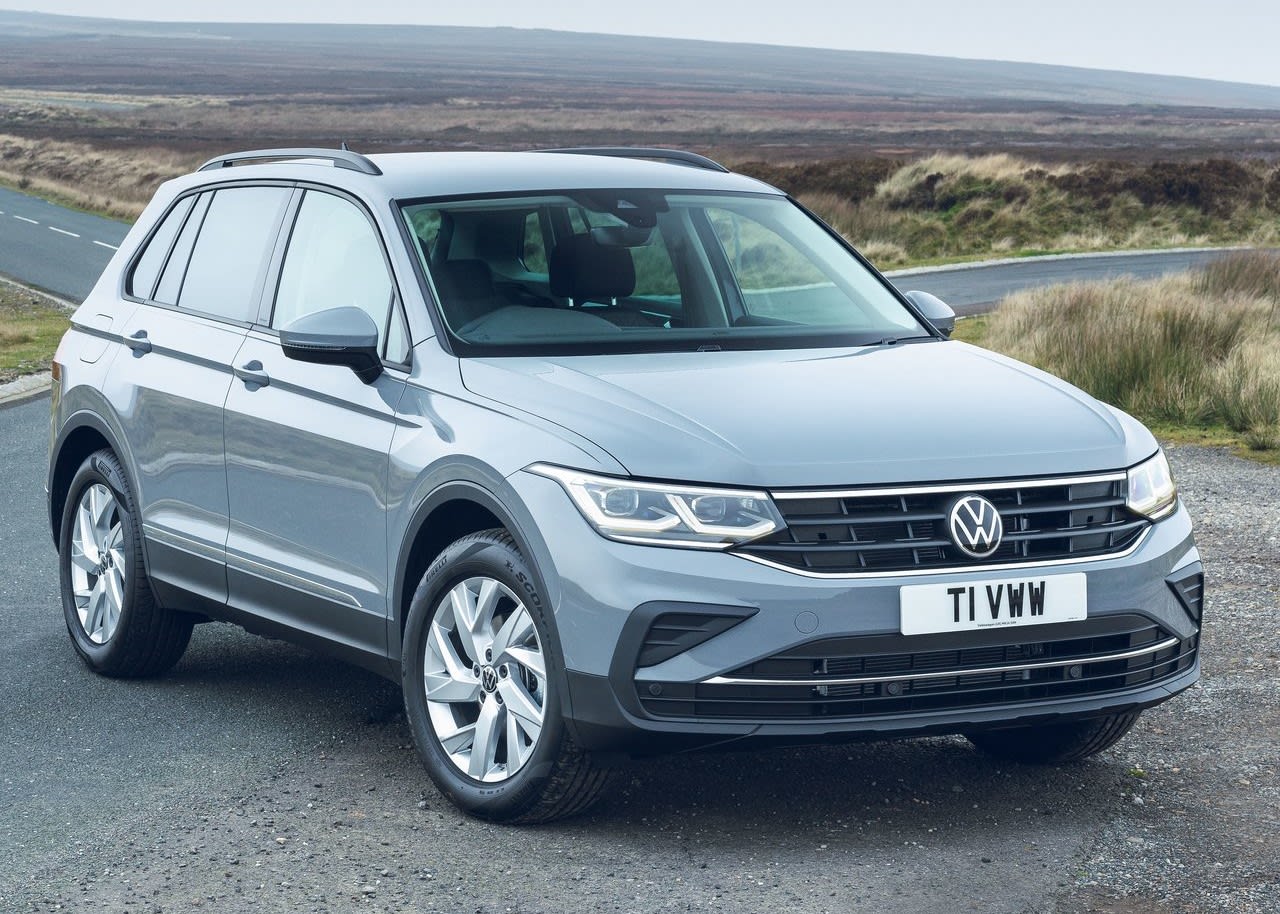
Key Features
The Tiguan stands out by being a jack of all trades, and a master of some. It’s decent to drive – albeit not quite as good as the class leader, the Mazda CX-5 – and it comes with plenty of technology, especially if you opt for a high-spec model. The 615-litre boot is among the best in the class, the build quality is second only to premium brands such as Audi and Porsche, and it has an understated style that makes it appealing to everyone.
But the car does have one or two really clever features that endear it to customers. The in-cabin storage, for example, is particularly clever, with a hidden drawer under the passenger seat and neat fold-out cupholders that turn a big cubby hole into a lean, mean cappuccino-transporting device.
.jpg)
Then there’s the heated steering wheel, which sounds like a complete gimmick until you drive the car on a cold morning. You know when your hands hurt after scraping the ice off the windows? Get behind the wheel, flick the switch and feel your hands toast on the wheel rim. And if it gets a bit too much, the heating comes in three stages to help you get just the right temperature.
Performance & Drive
The Tiguan comes with a broad selection of engines, which means there should be something for everyone. The basic unit is a 1.5-litre petrol engine that produces 130hp and comes with a six-speed manual gearbox. Move up the range and you can get a 150hp version of the same engine, and that comes with the option of a seven-speed automatic gearbox.
Alternatively you can go for diesel power, with a choice of 2.0-litre engines to pick from. The basic 150hp engine is fast enough, and you can have it with manual or automatic gearboxes. You even get the option of four-wheel drive. But there’s another way, with a 200hp version of that engine available on Elegance and R-Line versions. It’s even faster, but it’s only available with the seven-speed automatic gearbox and four-wheel drive.
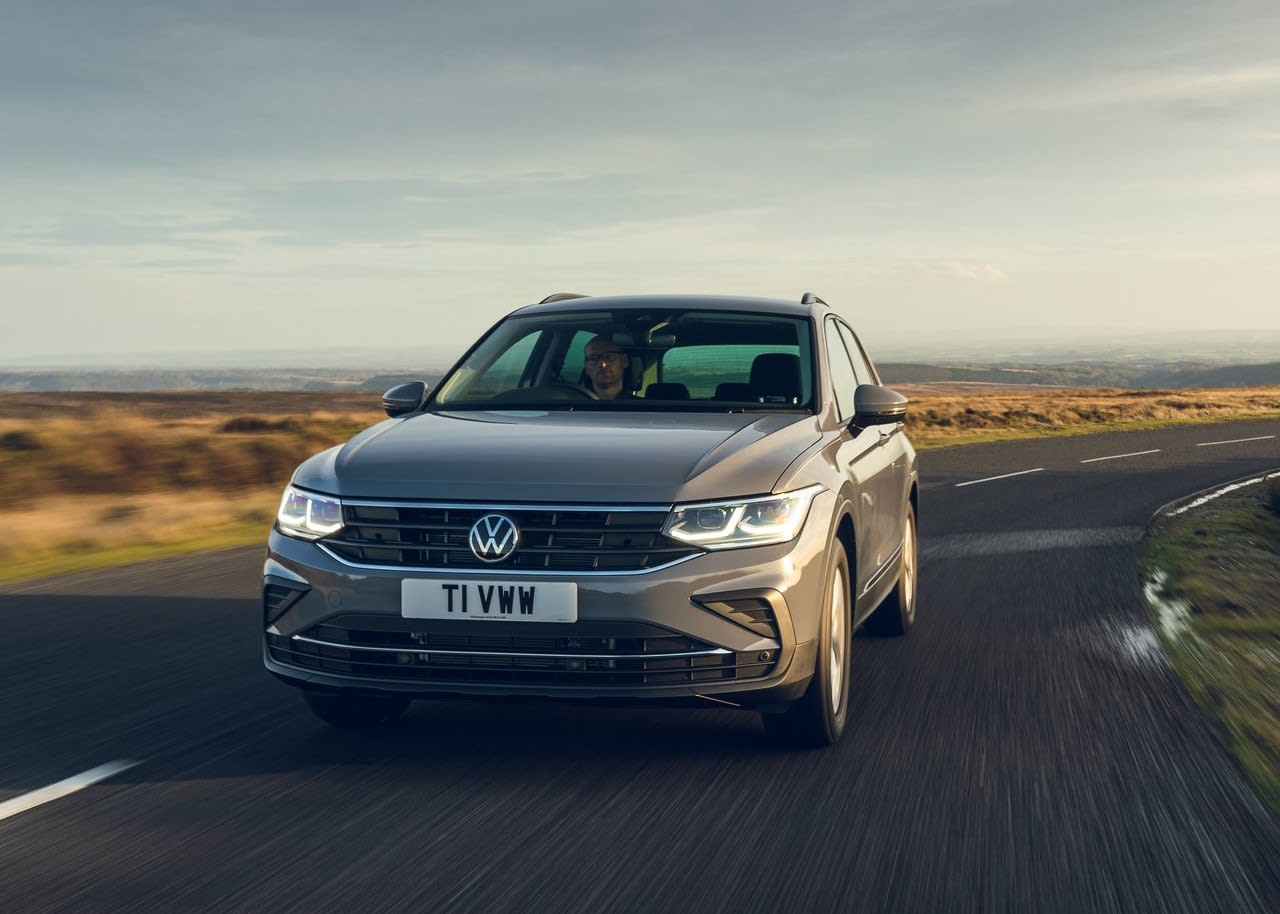
But if you want performance, you’ll probably opt for one of the high-powered petrol engines. All three are 2.0-litre four-cylinder engines with seven-speed automatic gearboxes and four-wheel drive as standard, but they’re only available on high-end cars. The 190hp engine is offered on Elegance and R-Line models, while the 245hp version (stolen from the Golf GTI) is found on R-Line models alone. The 320hp unit from a Golf R is exclusive to the Tiguan R, allowing 0-62mph in 4.9 seconds.
Naturally, the R and R-Line cars are the most dynamically capable, what with their sports suspension and, in the case of the R, high-performance brakes. But every Tiguan drives sweetly, with well weighted steering that elicits a sharp response from the front wheels. There’s some lean through fast corners, but it’s quite stable for such a tall car. Of course, the Tiguan will never be as agile as a Golf, but it gets closer than you might think. It’s certainly as good as the Seat Ateca and Skoda Karoq, although it’s slightly less fun than a Mazda CX-5.
Perhaps more importantly, it’s easy to drive around town thanks to good visibility and a high driving position, and it’s great on the motorway. The engines are all punchy enough to keep pace with the traffic, and the diesels merely sip fuel. It feels planted and secure no matter what, and although the large alloys and run-flat tyres of high-spec versions threaten to spoil the ride, it’s generally very supple and surefooted.
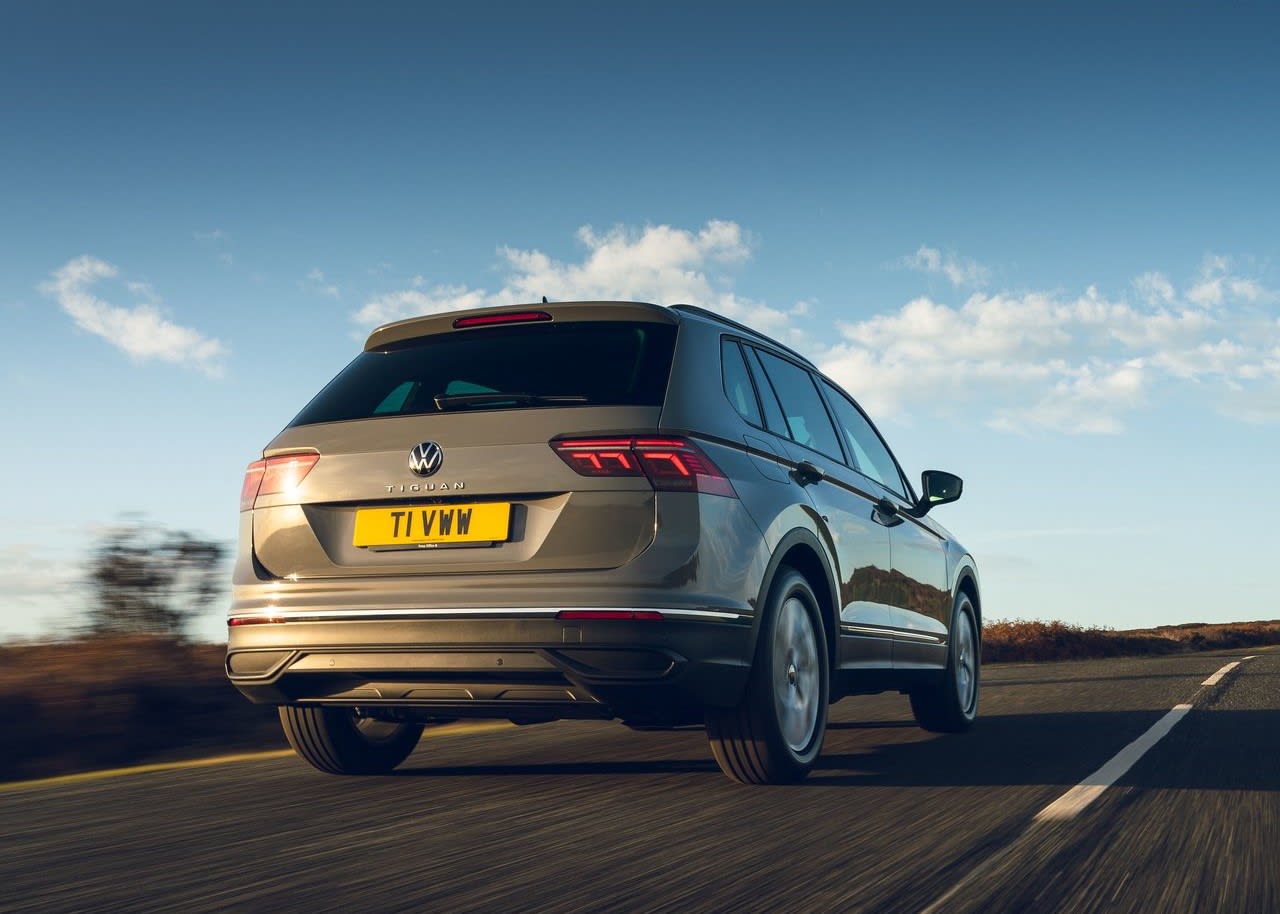
If you go for the 4Motion all-wheel drive system, you’ll also get a decent off-roader. Land Rover won’t have any sleepless nights about it, but the Tiguan is more than capable enough for most customers. It’ll keep making progress no matter how muddy the fields may be. It’ll cope with sandy beaches or snowy lanes, too, aided by the Active Control system that allows the driver to set the car up for the surface under the wheels.
Running Costs & Emissions
If you want an efficient SUV, you’ve come to the right place. The diesel versions of the Tiguan are more parsimonious than the figures might have you believe, with the basic 150hp manual managing more than 50mpg on the official economy test. On a long run, you’ll probably beat that figure quite easily. We’ve had more than 50mpg from a 150hp diesel with the automatic gearbox and four-wheel drive – a car that’s supposed to manage around 42mpg on the official test.
For many, though, the Tiguan will be let down by its lack of plug-in hybrid options. With only diesel or petrol power to choose from at present, the carbon dioxide emissions are higher than those of plug-in hybrid alternatives. Where a Toyota RAV4 Plug-In will manage 22g/km, putting it in the 11% company car tax bracket. The most frugal Tiguan, the 2.0 150hp diesel, will emit at least 134g/km, meaning you’ll pay at least 30% tax.
However, a plug-in hybrid is on its way, with a 1.4-litre petrol engine and a 31-mile electric range. That car is expected to make the Tiguan substantially more competitive on the emissions front, and it will likely be the model of choice for company car drivers.
Interior & Technology
As you’d expect from a Volkswagen, the Tiguan’s interior is impeccably built, if not especially inspiring. The plastics are all high quality, and the ergonomics are second to none. Every button is exactly where you expect it to be, and every switch moves in a logical, well-thought-through kind of way.
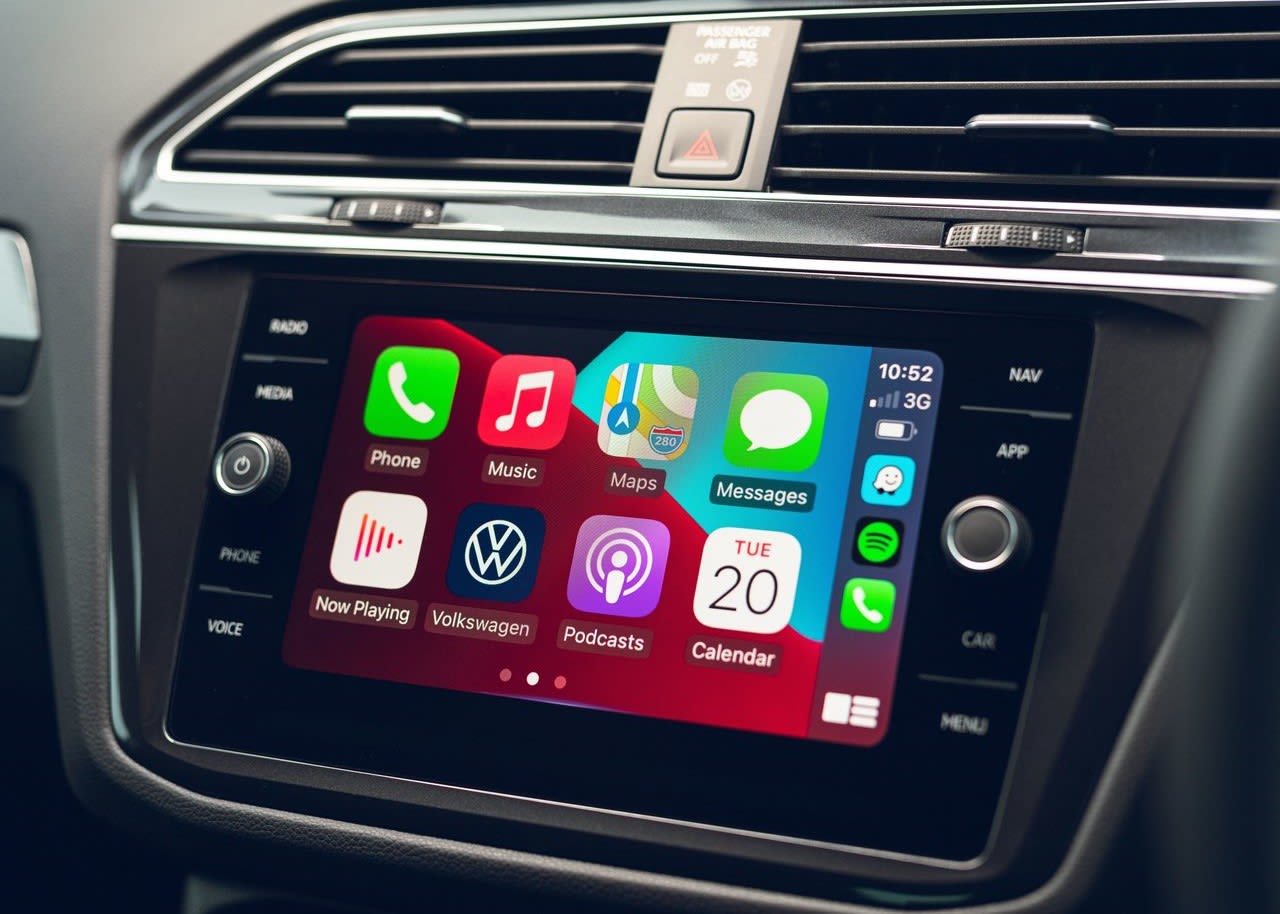
The coolest part of the Tiguan's interior is the digital instrument cluster found on high-spec cars, which can be configured to show you exactly what you want. Whether you're trying to find out how much fuel you're burning or how to get to Scunthorpe, you can get it up on the screen in front of you.
But the eight-inch screen in the middle is the one that matters. That clear, easy-to-use touchscreen gives you instant access to all the infotainment systems on board, as well as some of the vehicle functions. In true Volkswagen style, it isn't the most exciting display to look at, but it's functional and intuitive. And VW hasn't fallen into the trap of hiding everything away in the infotainment system. You still get separate buttons for the climate control, a proper volume dial and, in all-wheel-drive versions, a rotary dial in the centre console to access the off-road driving modes.
If you're into your tech, you'll also be pleased to see wireless Apple CarPlay and Android Auto connectivity on offer, as well as a fleet of USB-C ports. If you really want more kit to play with, consider specifying the head-up display or the Harman/Kardon audio system, which sounds crystal clear.
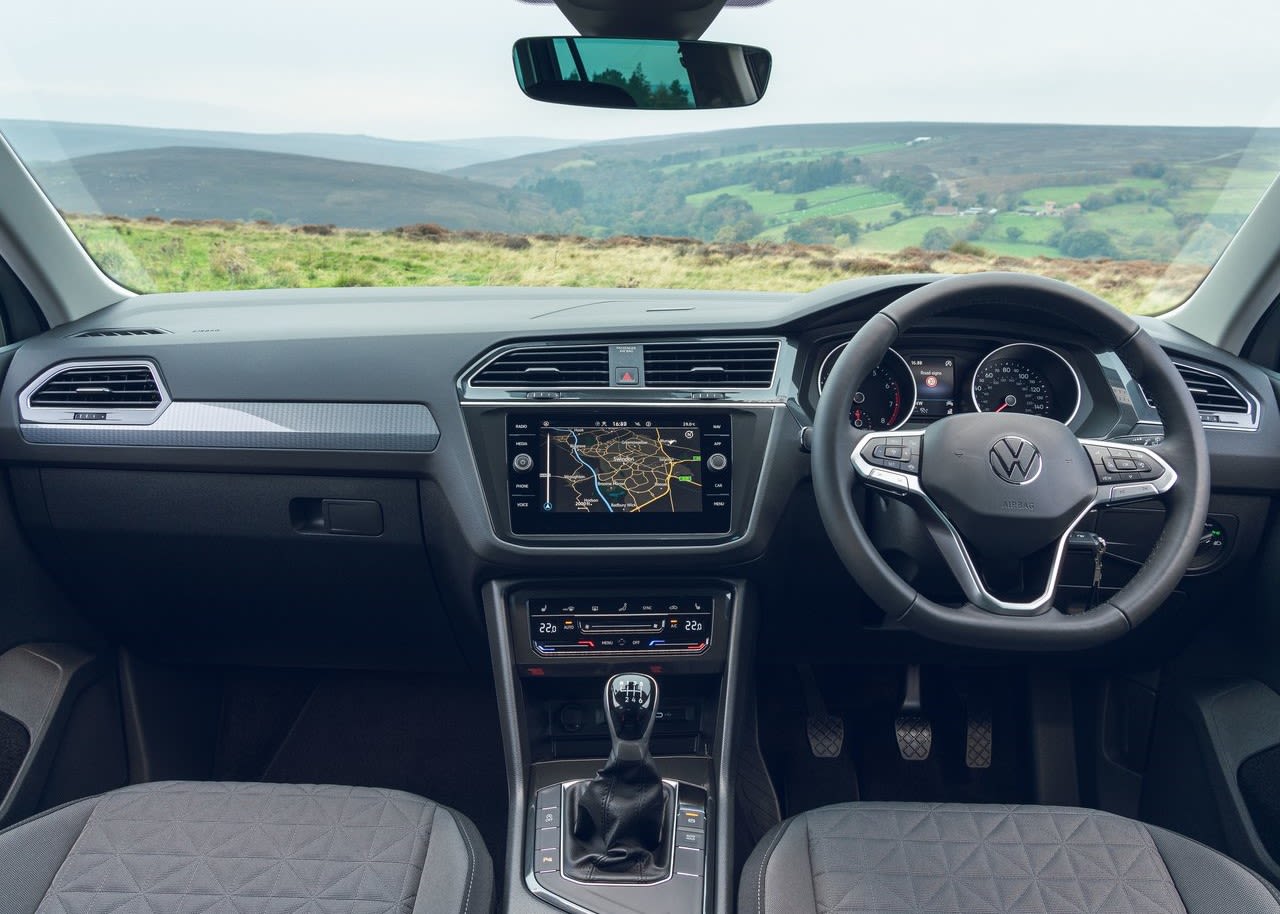
Practicality & Boot Space
The Tiguan is arguably the perfect family car, with bags of room wherever you look. From the driving seat, you’ll have plenty of headroom and shoulder room, while the passenger gets much the same kind of space – albeit without the inconvenience of pedals in the footwell. You get plenty of cubby holes, too, with decent-sized door bins, a drawer under the passenger seat and reasonably big glove box.
Further back, you’ll find a capacious rear bench seat, with room for two adults to sit in perfect comfort. You can fit in a third rear-seat passenger, but it’s a bit cramped and the seat isn’t that comfortable. For a short journey, though, it’s a legitimate option.
Open the boot and you’ll find even more space. The Tiguan has a 615-litre boot, and that’s when you only fill it to the window line. If you can pack it to the rafters, you’ll find even more space. Alternatively, you could just fold the rear seats down. The floor you're left with is almost flat, and you can fit longer items by folding the front passenger seat flat. That gives you almost van-like load-carrying capability.
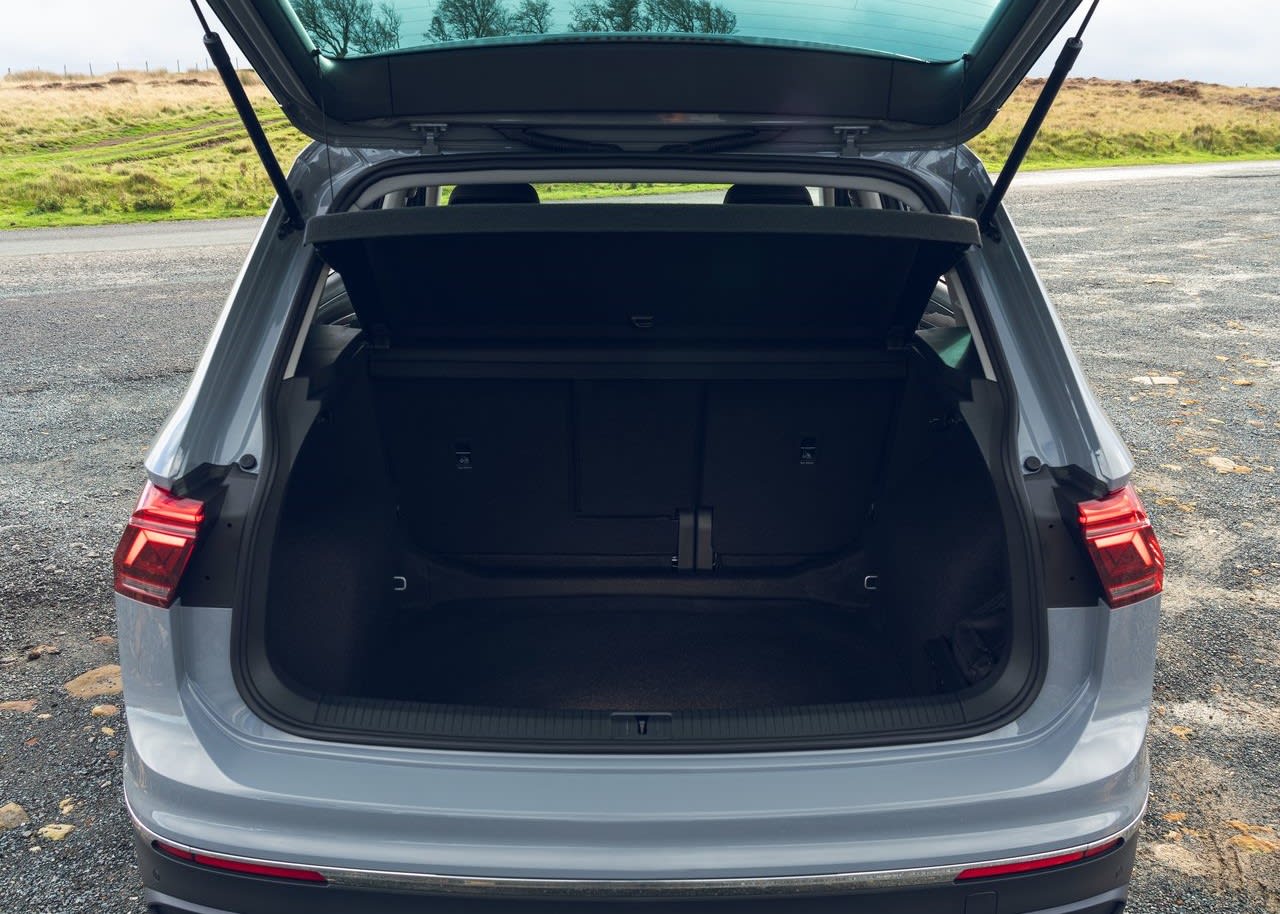
Safety
Because structural changes have been few and far between, the new Tiguan effectively inherits its predecessor’s safety rating. That’s no bad thing, though, because the old car performed extraordinarily well in the Euro NCAP crash test. Back in 2016, it scored 96% for adult occupant protection, and an impressive 84% for child occupant protection.
These days, the car also comes with a veritable armada of safety gadgets, all designed to stop you having a crash in the first place. As standard, you get autonomous emergency braking that can hit the brakes for you if you fail to react to an impending collision, and you get lane-keeping assistance.
Move up the range and radar-assisted cruise control is joined by front and rear parking sensors, a rear-view camera and parking assistance tech. Really high-end cars get blind-spot monitoring and Travel Assist, which allows the cruise control and lane-keeping tech to combine, giving the car semi-autonomous capability. It’s an assistance system, rather than full self-driving technology, so you still have to drive. It’s a good backup system to have, though, particularly on a long drive.
Options
The Tiguan range is big, with a wide range of versions to choose from. The base model, which is only available with the 1.5-litre, 130hp petrol engine, comes with 17-inch alloy wheels, an eight-inch touchscreen infotainment system and manual air conditioning. Automatic windscreen wipers are included, along with the Apple CarPlay and Android Auto smartphone integration technology.
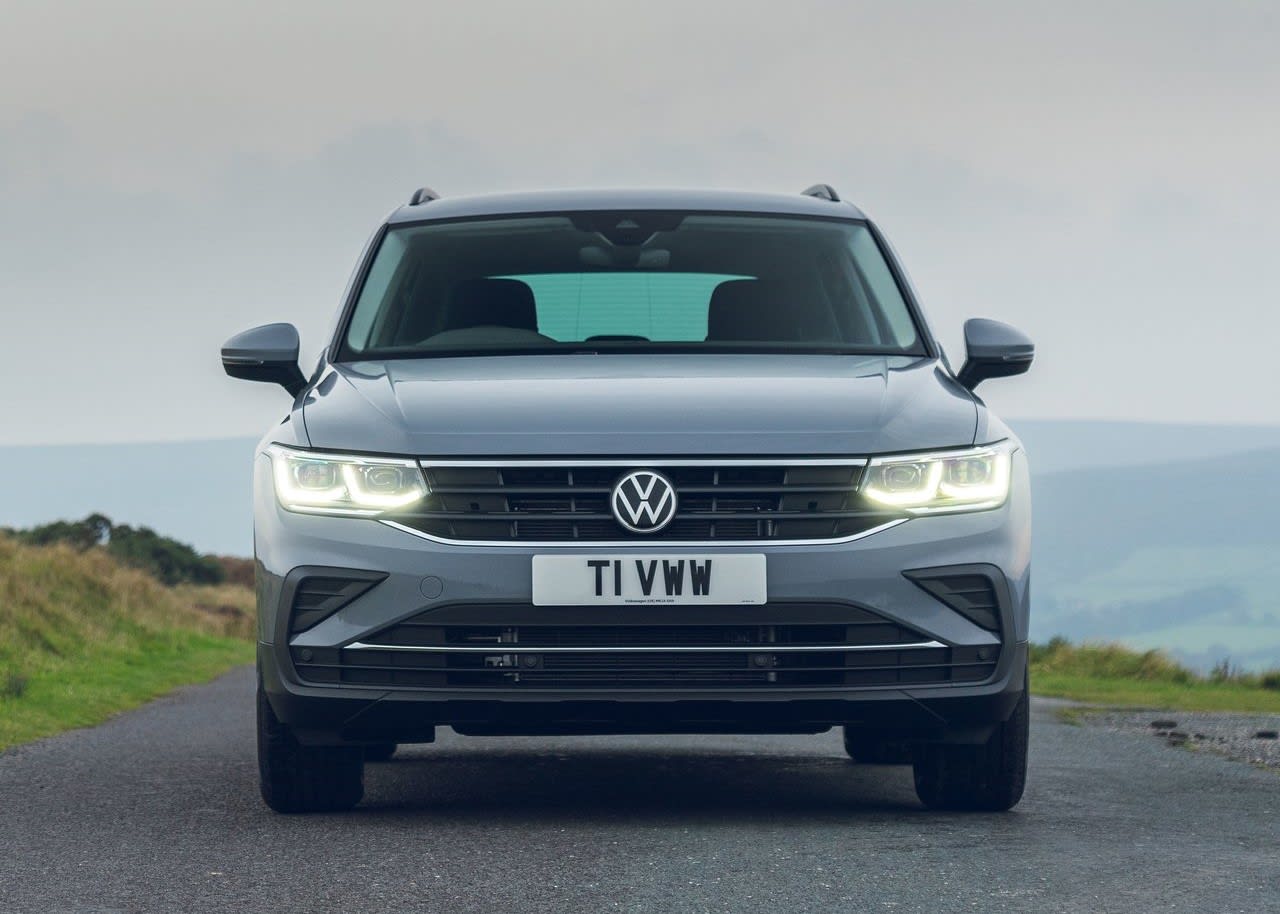
Opting for the mid-range Life model gets you larger 18-inch alloy wheels, three-zone climate control and satellite navigation. The Life also comes with black roof rails, front and rear parking sensors and adaptive cruise control that can maintain a safe distance between you and the vehicle in front.
Above the Life model, the range almost splits into three branches, with the Active model adding a slightly more rugged look. Heated seats, smaller 17-inch alloy wheels and special door sill protectors are some of the highlights, but there’s also a heated steering wheel, electrically operated tailgate and keyless entry.
Alternatively, you can go down the luxury route and pick the Elegance version. That car includes 19-inch alloy wheels, silver roof rails and clever LED matrix headlights. The long specification list also features heated front seats, a panoramic sunroof and a heated steering wheel, not to mention the digital instrument cluster, rear-view camera and keyless entry system.
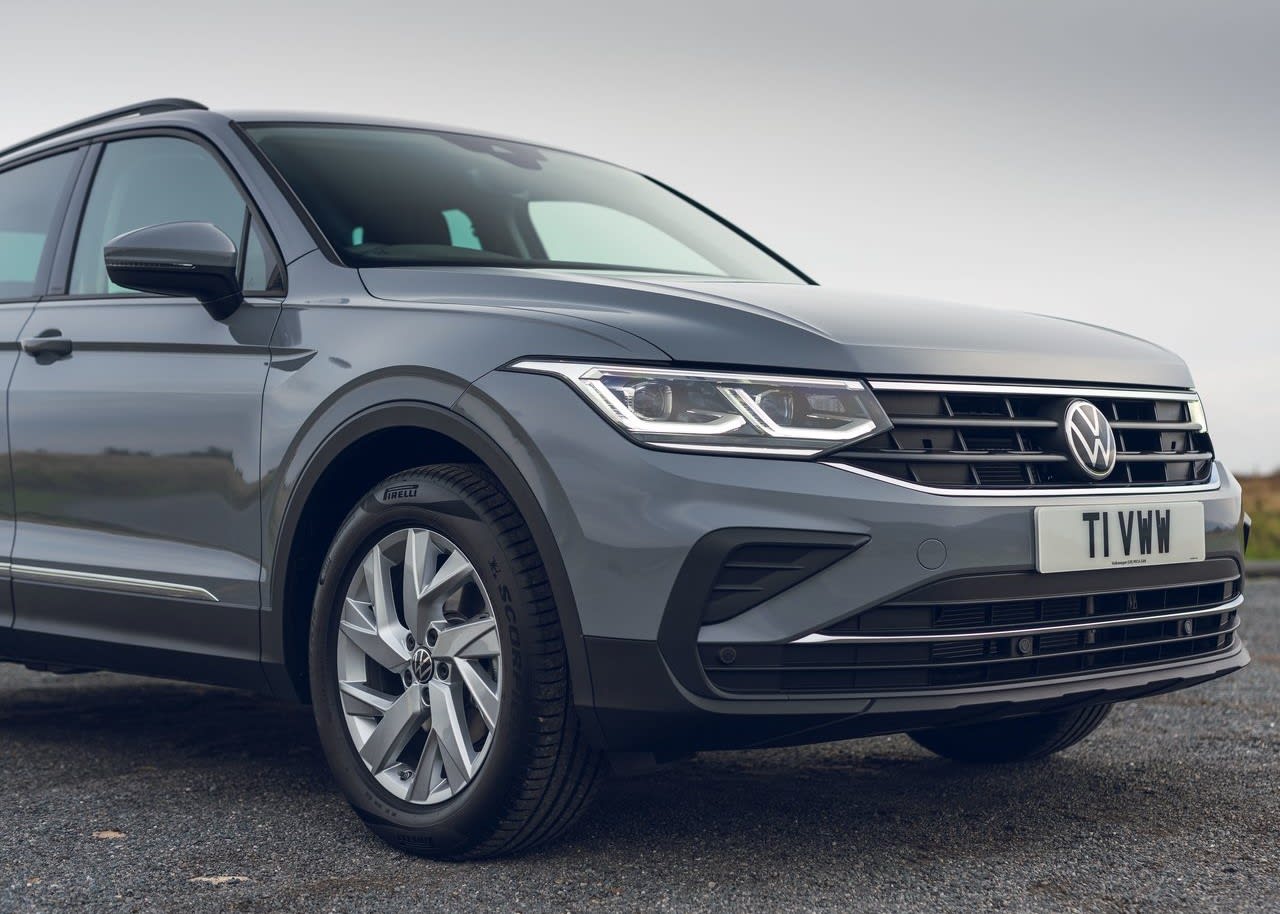
The other option is the sporty R-Line model, which gets sportier bumpers and a more pronounced rear spoiler, not to mention the 20-inch alloy wheels and sports suspension that sees the car sit around 10mm lower than standard. Like the Elegance, the R-Line comes with a digital instrument cluster, keyless entry and a heated steering wheel, but it also gets heated sports seats, stainless steel pedals and some R-Line interior trim features.
The high-performance R model gets its own exclusive specification list, with 21-inch alloy wheels, model-specific bumpers and exterior styling features, and high-performance brakes. Inside, the R gets the digital instrument cluster, heated steering wheel and heated seats from the R-Line, but it also includes the Elegance’s rear-view camera.
As if all that choice wasn’t enough, Volkswagen has also given customers a wide range of options to pick from. You can have a head-up display, heated rear seats or leather upholstery, and there’s a larger 9.2-inch touchscreen for those who want it. You can also get a Harman/Kardon sound system, which sounds brilliant.
Aside from that, all the usual options are also available, with a selection of paint colours and alloy wheel designs. Colour palette highlights include the gorgeous Nightshade paintwork, as well as Kings Red and Lapiz Blue.
Rival Cars
The family SUV market is crowded, and there are some strong contenders in the mix. The Tiguan has its work cut out competing with the likes of the lively Ford Kuga, the comfy, solid Kia Sportage and the stylish Peugeot 3008. Other contenders include the recently revamped Nissan Qashqai, the roomy Renault Kadjar or the comfy Citroen C5 Aircross. If you want great handling and a Tiguan-rivalling sense of premium-ness, however, you need the Mazda CX-5.
And if attractive leasing deals put you in the market for something more premium, consider the fashion-conscious Range Rover Evoque, the high-tech Mercedes-Benz GLA or even the oh-so-Scandinavian Volvo XC40. You could look at the BMW X1 if you want something more dynamic, but it’s hard to beat the Audi Q3 in terms of quality.
But the Tiguan’s biggest rivals are its cousins. Mechanically speaking, the Skoda Karoq and Seat Ateca are pretty much identical to the Tiguan, and both have their own unique characters. The Karoq is more rugged and practical, whereas the Ateca feels more youthful and sportier. But the Tiguan is the more upmarket option, and it’s every bit as good to drive as its surprisingly agile relations.
Verdict & Next Steps
The Tiguan has always been among the market leaders, but the latest-generation model comes with even more sense that it can be all things to all drivers. Whether you’re after a family car that’s spacious, fun to drive or capable off-road, the Tiguan can do it. And it does it all with this semi-premium image that makes it look and feel at home no matter where you take it. From the local football club car park to the ambassador’s tea party, the Tiguan never feels out of place. All of which makes it one of the best all-rounders you can lease.
Where to next?
View latest Volkswagen Tiguan leasing deals - guide price from £229.99 per month inc VAT**
Looking for a great leasing deal? Check out our incredible range of car lease deals
New family SUV? Read our latest Reviews and find the right model for you
Want to know more about leasing? Take a look at our comprehensive Leasing Guides
Interested in everything motoring? Why not catch up on all the latest Car Leasing News.
*Score based on Select’s unique meta score analysis, taking into account the UK’s top five leading independent car website reviews of the VW Tiguan
**Correct as of 07/06/2021. Based on 9 months initial payment, 5,000 miles over a 48 month lease. Initial payment equivalent to 9 monthly payments or £2069.82 Ts and Cs apply. Credit is subject to status.





















